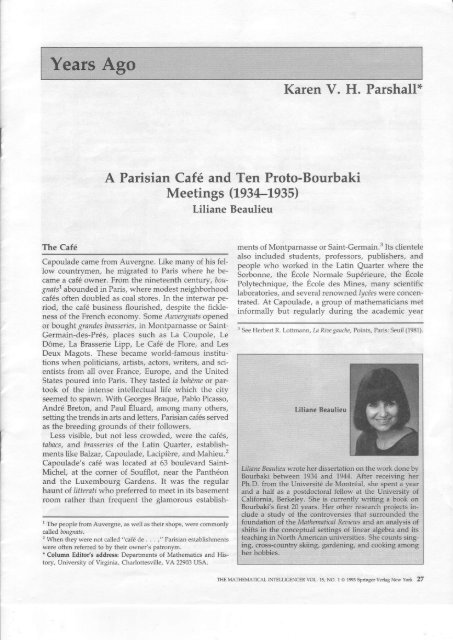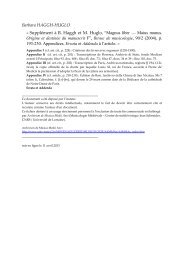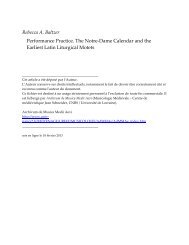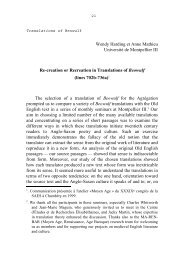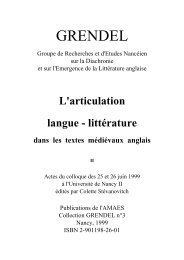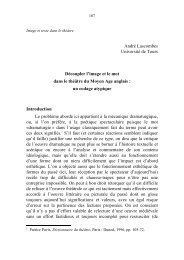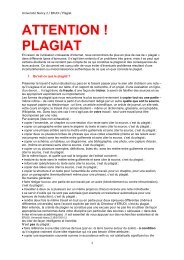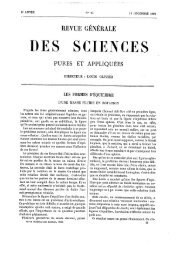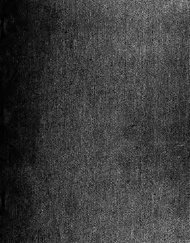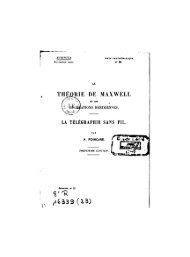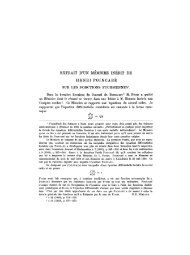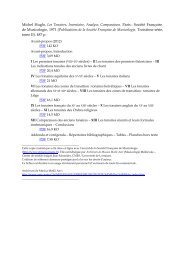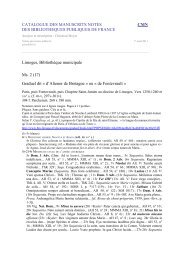Karen V. H. Parshall" A Parisian Café and Ten Proto-Bourbaki ...
Karen V. H. Parshall" A Parisian Café and Ten Proto-Bourbaki ...
Karen V. H. Parshall" A Parisian Café and Ten Proto-Bourbaki ...
You also want an ePaper? Increase the reach of your titles
YUMPU automatically turns print PDFs into web optimized ePapers that Google loves.
The <strong>Café</strong><br />
<strong>Karen</strong> V. H. Parshall"<br />
A <strong>Parisian</strong> <strong>Café</strong> <strong>and</strong> <strong>Ten</strong> <strong>Proto</strong>-<strong>Bourbaki</strong><br />
Meetings (L934-L935)<br />
Liliane Beaulieu<br />
Capoulade came from Auvergne. Like many of his fellow<br />
countrymen, he migrated to Paris where he became<br />
a café owner. From the nineteenth centLrry, bou<br />
gnafsl abounded in Paris, where modest neighborhood<br />
cafés often doubled as coal stores. ln the interwar period,<br />
the café business flourished, despite the fickleness<br />
of the French economy. Some Auaergnafs opened<br />
or bought gr<strong>and</strong>es brasseries, in Montparnasse or Saint-<br />
ments of Montparnasse or Saint-Germain.' Its clientele<br />
also included students, professors, publishers, <strong>and</strong><br />
people who worked in the Latin Quarter where the<br />
Sorbonne, the École Normale Supérieure, the Ëcole<br />
Polytechnique. the Ecole des Mines, many scientific<br />
laboratories, <strong>and</strong> several renowned lycées were concentrated.<br />
At Capoulade, a group of mathematicians met<br />
inforrnally but regularly during the academic year<br />
3<br />
See Herbert R. Lottmann, La Ril',egar.fts, Points, Paris: Seuil (1981).<br />
Cermain-des-Prés, places such as La Coupole, Le<br />
Dôme, La Brasserie Lipp, Le <strong>Café</strong> de Flore, <strong>and</strong> Les<br />
Deux Masots. These became world-famous institutions<br />
when politicians, artists, actors, writers, <strong>and</strong> scientists<br />
from all over France, Europe, <strong>and</strong> the United<br />
States poured into Paris. They tasted Ia bohème or partook<br />
of the intense intellectual life which the city<br />
seemed to spawn. With Georges Braque, Pablo Picasso,<br />
André Breton, <strong>and</strong> Paul Éluard, among many others,<br />
Liliane Beaulieu<br />
setting the trends in arts <strong>and</strong> letters, <strong>Parisian</strong> cafés served<br />
as the breeding grounds of their followers.<br />
Less visible, but not less crowded, were the cafés,<br />
tabacs, <strong>and</strong>. brasseries of the Latin Quarter, establishments<br />
Iike Balzar, Capoulade. Làcipière, <strong>and</strong> Mahieu.2<br />
Capoulade's café was located at 63 boulevard Saint-<br />
Liliane Beaulieu wrote her dissertation on the work done by<br />
Michel, at the corner of Soufflot, near the Panthéon<br />
<strong>Bourbaki</strong> between lq34 <strong>and</strong> 1944. After receivins hir<br />
<strong>and</strong> the Luxembourg Gardens. It was the regular Ph.D. from lhe Lniversité de Montreal, .he .pent i vear<br />
ha,Jnt of littersti who preferred to meet in its basement <strong>and</strong> a hall as a postdoctoral lellow at the University of<br />
room rather than frequent the glamorous establish- California, Berkeley. She is currently writing a book on<br />
<strong>Bourbaki</strong>'s first 20 years. Her other rcsearch projects include<br />
a studv of the controversies that surrounded the<br />
'<br />
The people from Auvergne, as well as their shops, were commonly foundation o? the M athemqtical Reaie:aos <strong>and</strong> an analysis of<br />
called àolgnafs.<br />
shifts in the conceptual settings of linear algebra <strong>and</strong> its<br />
2<br />
When they were not câlled "café de . . - ," Pa sian establishments teaching in North American universities. She counts sing-<br />
were often refeûed to by their owner's patronym.<br />
ing, cross-country skiing, gardening, <strong>and</strong> cooking among<br />
* Column Editoi's address: Departments of Mâthematics <strong>and</strong> His- her hobbies.<br />
tory, University of Virginia, Charlottesville, VA 22903 USA.<br />
THE MATHEM^TIC^L I^'TEI-I-ICENC! VOL 15, NO I O 1993 SprinAe.-V€rlas New York 27
I<br />
1934-35. The loose circle gradually formed a real working<br />
team <strong>and</strong> later became famous for its rnanyvolumed,<br />
perpetually revise d treatise entltled ÊIéments<br />
de Mathêmatique,a which has been published under the<br />
pseudonym "Nicolas <strong>Bourbaki</strong>" from 1939 to the present.<br />
The First Meeting <strong>and</strong> Its Context .<br />
December 70, 19U. At the sacred hour of noon, Capoulade<br />
is filling up. Henri Cartan, Claude Chevalley,<br />
fean Delsarte, Jean Dieudonné, René de Possel, <strong>and</strong><br />
André Weil meet----over a lunch of cabbage soup <strong>and</strong><br />
grilled meats served with endùtes braisées or Wmmes<br />
" The singular was fâvored over the usual plulal. BouÈaki chose this<br />
title around 1938. The pseudonlan was chosen in the summer of<br />
1935.<br />
soufflées-to exchange views on a new proiect.s Weil<br />
opens the discussion with a general but firm statement<br />
which maps out the perspective. The goal of the venture<br />
will be "to define for 25 years the syllabus for the<br />
certificate in differential <strong>and</strong> integral calculus by writing,<br />
collectively, a treatise on analysis. Of course, this<br />
treatise will be as modern as possible."6 All are ardently<br />
in favor. The principle of collective writing<br />
makes good sense. Because analysis touches on such<br />
di{ferent specialties, the work of many people will allow<br />
better <strong>and</strong> more thorough coverage. Delsarte is<br />
particularly insistent on this issue, but he also realizes<br />
that by sharing the writing the group will leave no<br />
" The reports on the meetings, which were used as a prirnary soutce<br />
for this account, are analyzed <strong>and</strong> described extensively by Liliane<br />
Beaulier l<strong>Bourbaki</strong>. Une histoie du gtoupe de mathélruticiefis fronçik et<br />
(k ses trqLvux, 1934-1944, 2 vols. (Ph.D. dissertation, Université de<br />
MontÉal, 1989)1.<br />
6<br />
Translation by the âuthor.<br />
"<strong>Café</strong>, grill-room, A. Capoulade," 63 boulevard Saint-Michel, comer of Soufflot, Paris (1934). Until recentlv, this café was<br />
a m€eting Point for the artiets, students, professors, publishers,_<strong>and</strong> employees who haunted the neighborÉood where the<br />
Sorbonne, Ecole Normale Supérieure, École Polytechnique, École des l\iines, scientific laboratories, <strong>and</strong> h1cées wete<br />
co,ncenttated, Inside the café, trdo rooms accommodaled pahons for meals <strong>and</strong> drinks. The basement room wasïften used<br />
for meetings. In the unrestrained atmosphere oI the Latin Quarter <strong>and</strong> free from the constraints of the university, it served<br />
the needs oI the proto-<strong>Bourbaki</strong>s. Copyright Agence Roger-Viollet, photo Boyet.<br />
28 rrc verruueTlcel TNTELUGENCER vol. rs. No. r. ree3
At the sarne address now st<strong>and</strong>s a fast-food restaurant in the "QuiclC' chain, The population of the Latin Quarter, especially<br />
,ycéestudents, still constitutes part of the clientele, but the style of the restaurant does not lend itself to lengthy <strong>and</strong> intense<br />
meetings. Good old "côte" wine is no longer served, <strong>and</strong> the basement room now houses arrays of huge freezers. Like a<br />
reminder of the int€rwar years, th€ poster on the right in the foreground advertises an exhibition of work; by André Breton<br />
ar.d his cafés-habit tés, surrealist companions. Photo by Liliane Beaulieu, June 1991.<br />
traces of individual authorship <strong>and</strong> mav therebv safeguaïd<br />
against future claims to intelectual prcpêrq.7<br />
In the ensuing discussion, all but one participant<br />
agree that the treâtise should be geared to teaching<br />
rather than reference. Someone mentions that it<br />
should cover about 1000 pages. Delsarte urges that the<br />
treatise should appear quickly, within 6 months, so as<br />
to assure surprise. Consequently, they agiee to set a<br />
definitive table of contents by the summer of 1935,<br />
when a general meeting will convene to parcel out the<br />
various writing tasks.<br />
At the time of the fust meeting, "differential <strong>and</strong><br />
integral calculus" <strong>and</strong> "analysis" were nearly synonymous<br />
in French mathematics instruction. The courses<br />
offered to students who registered for the licence in<br />
mathematics changed very little in the twenties <strong>and</strong><br />
the thirties. In Paris, thev chose from: differential <strong>and</strong><br />
7 These thoughts of Delsarte were not lecorded in the report on the<br />
fust meeting. Most likely they were expre$ed at some other time.<br />
They were recounted by his colleagues, Cartan <strong>and</strong> Weil. See Henri<br />
Cartan, SurJean Delsarte, in "Hommâge à Jeàn D;lsarte," Nicftifutsll<br />
Bunka 25 (1970\, 27-&.<br />
integral calculus, advanced geometry, râtional mechanics<br />
(or analytic mechanics <strong>and</strong> celestial mechanics),<br />
application of analysis to geometry, group theory<br />
<strong>and</strong> calculus of variations (or function theory <strong>and</strong> the<br />
theory of transformations), probability <strong>and</strong> mathematical<br />
physics, <strong>and</strong> general physics.8 Another course,<br />
mathématiques générales, was a prerequisite for physics<br />
<strong>and</strong> mathematics students alike. Each course <strong>and</strong> its<br />
examinations constituted a "certificate" <strong>and</strong> three such<br />
certificates were required for the /icence degree.e A provrnclal<br />
faculté des sciences oflered. fewer choices. Everywhere,<br />
though, "calculus" was the core of the mathematics<br />
curriculum, <strong>and</strong> so it was a traditional Dractice<br />
for professors to write a textbook on analysis.<br />
-<br />
The French Cours d'analyse belonged to a particular<br />
textbook genre. Some of these, like Édouard Goursafs<br />
Cours d'analyse mathématiqu3 <strong>and</strong> Jacques Hadamard's<br />
Cours d'analyse professé à I'EcoIe Polytechnique, sternrned<br />
3<br />
Course announcements, Faculté des sciences de Paris, 1920-1939,<br />
Archives nationales, Box 61AJ161.<br />
e<br />
The licence was then roughly equivalent to the upp€r levels of underqraduate<br />
instruction in the befter American univergities.<br />
THE MATHEMATTCAL tNrËLucENcER vol. 1s, No. 1, r99o 29
F<br />
essentially ftom <strong>and</strong> were written for the dassroom.lo<br />
Others, like Camille Jordan's Cours d'analyse de l'Ê,cole<br />
Polytechnique (despite its title) <strong>and</strong> Émile Picard's Tralté<br />
d'analyse,,were more elaborate, true general analysis<br />
treatises. " These books integrated relatively recent results<br />
together with some of their authors' own mathematical<br />
work.<br />
The <strong>Parisian</strong> professorial lectures dominated French<br />
mathematics instruction, <strong>and</strong> some consensus had de-<br />
Many physicists who use methods of integration <strong>and</strong> operations<br />
on series obtain exact numerical tesults but are<br />
convinced meanwhile that they are committing some<br />
mathematical heresies. This stems from the fact that, in<br />
most analysis treatises, fundamental theorems, such as<br />
methods of calculation, existence theorems, etc., are introduced<br />
with a rather impressive wealth of precautions.<br />
These theorems contain an overabundance ofÏl'potheses.<br />
ln many cases,,it wilJ be necessary for us to reconsider<br />
such theorems."<br />
veloped among university teachers ihroughout the<br />
country as to which textbooks to adopt. Thus, not<br />
atypically, Goursa/s book had a long shelflife, guiding<br />
French mathematicians in the "calculus" even in the<br />
1950s. Although a system as centralized as the French<br />
Unioercité network ostensibly fostered neither change<br />
nor originality it did, however, support them in actual<br />
practice. Instructors, <strong>and</strong> especially professors, were<br />
free to teâch their subiect as they wanted. So, in conbast<br />
to the ossified, albeit remarkable teachings of immortal<br />
masters, the instructors <strong>and</strong> professois in the<br />
different facultés des sciences often tâught from their<br />
own notes. Provincial university teachers mav have<br />
enjoyed even greater freedom in this regard than their<br />
more established <strong>Parisian</strong> counterparts. The proto-<br />
<strong>Bourbaki</strong>s intended to make full use of that freedom.<br />
Judging by the contents of Goursafs book, a French<br />
course on differential <strong>and</strong> integral calculus typically<br />
drew from among the following topics: differentiaton,<br />
integration (definite <strong>and</strong> indefinite integrals, multiple<br />
integrals), series approximations of functions, geometry<br />
(envelopes, curves, surfaces), functions of a complex<br />
variable, analytic functions (Cauchy's theory, holomorphic<br />
functions, analytic continuation, functons<br />
of several variables), solution of differential equations<br />
(etstence theorems, linear <strong>and</strong> nonlinear differential<br />
equations), partial differential equations (first-order,<br />
Monge-Ampère, linear, elliptic, harmonic), integral<br />
equations (solution by approximations, Fredholm's<br />
theorems, applications), <strong>and</strong> introduction to the calculus<br />
of variations. The group assembled at Capoulade<br />
did not object to these topics in <strong>and</strong> of themselves. Its<br />
main qualm about Goursat's book <strong>and</strong> other current<br />
Cours d'analyse was that they misled their readers, especially<br />
physicists, on the nature of mathematical<br />
ngor.<br />
As the Committee sees it, special conditions do not<br />
necessarily yield more rigorous results. In the Coars<br />
d'analyse, theorems tended to appear several times in<br />
the text, each time with an added set of hvpothes€s.<br />
Thus, Cauchy's theorem was followed by boursat's<br />
version of it, <strong>and</strong> Stokes's theorem received similar<br />
beatment. The group at Capoulade wants to avoid this<br />
sort of repetition <strong>and</strong> to present material in a more<br />
general <strong>and</strong> modern setting.l3<br />
Indeed, they want their h€atise to be "as modem as<br />
possible"-with emphasis on the word "modem"-in<br />
contrast to a type of knowledge which they deem outmoded.<br />
But what does "as modern as possible" really<br />
mean? Where should they start? What topics should<br />
they include? These questions occupy them hom soup<br />
to coffee. Weil states that no topic should be eliminated<br />
a priori, whereas Cartan wonders whether it is appropriate<br />
to include algebra in an analysis treatise. As far<br />
as level is concemed, Cartan suggests that the equivalent<br />
of mathématiques générales be assumed- His colleagues<br />
protest: "We should start from saatch!"<br />
Soon after, they argue about which topic should<br />
come first: functions of real or complex variables?<br />
Whereas a majority favors treating the real before the<br />
complex case, all promptly agree with Weil <strong>and</strong> Chevalley<br />
that it would be best to introduce algebraic aspects<br />
of the theory of complex functions fi$t. Delsarte<br />
points out that, more generally, the treatis€ should<br />
stârt with an abstract <strong>and</strong> axiomatic exposition of some<br />
general but essential notions such as field, operation,<br />
set, <strong>and</strong> group, as in van der Waerden's boôk.Ia The<br />
group agrees <strong>and</strong> informally calls this introductory section<br />
the "abstract package lpaquet abstraitl." They further<br />
concur that it should be kept to a minimum, however,<br />
because notions can always be introduced later,<br />
as the needs of exposition dem<strong>and</strong>. Next, they argue<br />
10<br />
Édouard Goursat, Co urs d'ûfiollse mathématiqxe, 3 vols., Paris: Gauthier-Vilars<br />
(1902-1914 (a fifth edirion of the third volume appeared<br />
in 1956); A fj|sf cou6e it nqlhemûlical anallsis {Earle Rayrnond Heddck,<br />
trans.),3 vols., Boston-New York: Ginn & Co. (190+1914 (a<br />
Dover edition of this tnnslation appeared between 1959 <strong>and</strong> 1964);<br />
<strong>and</strong> Jacques Hadamâr d,, Cours d'analyse prolessé à I'Êale Pofutechniqte,<br />
Paris: Hermânn (1927). See also Hadamard's preface wherc he points<br />
out whi(h extra material he deemed useful io add.<br />
rr<br />
Camille Jordan, Cours d'arulyse de l'É,cole Polytechnique, 3 vols.,<br />
Paris: Gauthier-Villars (1882-1884 (a third edition oI volume three<br />
appeared in 1915); <strong>and</strong> Émile Picard, Traité d'analuse,3 vols., Parisl<br />
Cauthier-Villa$ (1891-1896) (a rhird edition of rh; rhird volume appeared<br />
in 1928).<br />
30 rne vetttpuerrcat- INTELLIcENCER vol. 15. No. r.1993<br />
12 Translation by the author. These were repoltedly Weil's own<br />
words.<br />
13<br />
Related in André Wetl, Oeuores scientifiqueÊ---Collected Popefi, Vol.<br />
1, New York Spdnger-Veilâg (1980), 563j a^d Souoenirs d'aryrentissage,<br />
Vita mathematica, Basel-Boston Berlin: Birkhàuser (191), 103_<br />
104. The latter work appeared in English translaiion as The Apprenticeship<br />
of a Mathenaticiar, Boston: Bitkhâuser (1992). A discussion of<br />
Bou:rbaki's treatment of Stokes's theorem appears in Liliâne Beau-<br />
lieu, Proofs in expository writing: Some eximples from <strong>Bourbaki</strong>,s<br />
early worlr, lntcrchange 2l (19901, 3145, on pp. 36-38.<br />
'"<br />
Bârtel L. van der Waerden, Moderne Algebra, 2 vols., Berlin:<br />
Springer-Verlag (1930-1931).
over the starting point: sets or operations <strong>and</strong> fields?<br />
They close the meeting unresolved. Weil convenes another<br />
meeting for rnid-]anuary, same time, same place.<br />
Each participant is told to bring along a list of iopics<br />
which he thinks should appear in the treatise.<br />
As it set out to write its modern analogue of the<br />
Cours d'analyse, the Committee already knew where it<br />
wanted to publish its work-with Hermann in its collection<br />
entitled "Actualités scientifiques et industrielles."<br />
Gauthier-Villars, the official acâdemic publisher<br />
The "Committee on Analysis" <strong>and</strong><br />
Its Participants<br />
of mathematics at the time, was out of lhe quàsdon for<br />
them. Some of the most conservative French mathematcians<br />
dominated its editorial board, iust as they<br />
controlled every other institutional body in the field. In<br />
contrast, Hermann stood somewhat on the frinee. It<br />
was a small, independent firm directed by an e-nterprising<br />
<strong>and</strong> eccentric Latin Quarter character, Enrique<br />
Freymann, who was always willing to venture into<br />
new proiects regardless of how financially unsound<br />
they might appear.<br />
Respectable mathematical texts, such as Éte Cartan's<br />
Lryons sur les inoariants intégraux <strong>and</strong> Hadamard, s<br />
Cours d'analyse had already beèn publshed by Hermann.rs<br />
Fuithermore, sevéral members of the Committee<br />
had recently had fust-h<strong>and</strong> experience with the<br />
publisher <strong>and</strong> its "Actualités." Soon àfter Lhe early dernise<br />
of their friend <strong>and</strong> colleague. Jacques Herbi<strong>and</strong>,<br />
Chevalley <strong>and</strong> Weil decided to publish a memorial volume<br />
of papers. They brought their proiect to Freymànn,<br />
<strong>and</strong> th,e articles soon appeared as a series in the<br />
"Actualités."'6 As a collection, the ,,Actualités,,<br />
The inJormal circle first called itself the<br />
had<br />
originated in 1929 <strong>and</strong> published monographs in the<br />
form of rather homely, paper-bound booklets. It encompassed<br />
a variety of series on science, some of<br />
which pertained to mathematics. Each series was<br />
headed by a dhector, who had full reign over content,<br />
qualty, <strong>and</strong> quantity of publication. For instance, Élie<br />
Cartan led a series on geometry, Maurice Fréchet<br />
headed one on general analysis, <strong>and</strong> Hadamard edited<br />
another on mathematical analysis <strong>and</strong> its applicâtions.<br />
A given series had limitations neither on duration nor<br />
on number of publicatons. This flexibility welcomed<br />
innovations <strong>and</strong> encouraged autonomy. Freymann<br />
<strong>and</strong> his "Actualités" thus provided the Capoulade<br />
group with the full editorial freedom it sought.l7<br />
,,Committee on<br />
Analysis" or "Committee for the Analysis Treatise.,,<br />
Delsarte apparently decided simply to wdte the title<br />
"Traité d'analyse" at the top of the reports on the<br />
meetings, although René de Possel once insisted that it<br />
should be changed to "Treatise on Mathematics.,, No<br />
one else supported this motion, <strong>and</strong> the title-page of<br />
the minutes remained the same for some time. -<br />
The notion of membership in the group was not<br />
clearly defined either. At the second meeting, the<br />
Committee decided to limit its numbers to the fàllowing<br />
nine pârticipants: Cartan, Chevalley, Delsarte,<br />
Dieudonné, Paul Dubreil, Jean Leray, Szolem M<strong>and</strong>elbrojt,18<br />
de Possel, <strong>and</strong> Weil. Dubré attended orùy a<br />
couple of meetings, <strong>and</strong> in May, Jean Coulomb, a<br />
physicist with â strong mathematical background, replaced<br />
him. Leray officially stayed on until the summer.<br />
Although he did not attend very regularly, he<br />
wrote out some of the more elaborate plans which occupied<br />
ihe Committee for several meetings. Later,<br />
when too few members showed up to discuss differentiàl<br />
equations, a quorum became essential. It was<br />
only in the summer of 1935 that the Committee<br />
adopted the pseudonym "<strong>Bourbaki</strong>.,, The participants<br />
who were present at that general meeting declared<br />
thernselves "official members" <strong>and</strong> in so doing finally<br />
defined membership.le<br />
From time to time, the members informallv invited<br />
others to join the discussions as guests o, âdrriro.".<br />
Thus, Emil Ariin attended a meeting of the Committee<br />
as a guest while visiting Paris Érom Hamburg in February<br />
1935. His presence did not seem to influlnce the<br />
meeting, however: a five-line-long outline for ,,set theory"<br />
went undiscussed, <strong>and</strong> measure <strong>and</strong> inteqration<br />
was the topic of conversation. To provide thé extra<br />
manpower needed to tackle di{fereniial equations, the<br />
Committee invited the physicist, Yves Roiard,2o as an<br />
advisor to inform them on what would be especiallv<br />
useful to physicists. Although Rocard's suggestions<br />
were labeled "the physicists' desiderata,,, they seemed<br />
mostly related to vibration <strong>and</strong> stability problerns, <strong>and</strong><br />
they did not convey a general picture ôf what physicists<br />
at the time might have needed as mathematical<br />
13<br />
Szolem M<strong>and</strong>elbrojt is an uncle of the mathemahcian Benoit M<strong>and</strong>elbrot<br />
of ftactals fame.<br />
D<br />
Charles Ehresmann was asked to join the group in place of Leray.<br />
As a point of nomenclature, I use the term ,,ploto-<strong>Bourbaki</strong>,, to<br />
designàte a pàrticipant in the early Committee. A ,<strong>Bourbaki</strong>,, 15<br />
Élie Cartan, Leçons sur les h1L\;iriants intéÙraut, pads: Hernann<br />
(1922). lor the relerence to Hadamard's texf, see footnote 10.<br />
16<br />
Claude Chevalley <strong>and</strong> André Weil (eds.), Êxwsés matb/natiql)es<br />
publiës à 1û mémoirc de I. Herbr<strong>and</strong>, Paris: Hermann (t934-lca5). This<br />
was an intemational project involving French a5 wejl às foreign conlributors.<br />
Among the French contributors, Henri Cafiàn, Delsarte.<br />
is<br />
Dieudonné,<br />
a<br />
Dubreil, <strong>and</strong> Weil were also among the proto- member of the group Bou.baki <strong>and</strong> is the official designation coined<br />
<strong>Bourbaki</strong>s. The papers presented in this sedes are listea in Be;uiieu, b), the gloup itself. A "<strong>Bourbaki</strong>st" is a follower ot B-ourbaki.<br />
Boufuaki. Unc Histoirc, Vol.2, pp.66a7.<br />
20<br />
17<br />
Rocard was in the same class as Delsalte <strong>and</strong> Weil at the École<br />
See Beaulieu, <strong>Bourbaki</strong>. tJne Histoire, Vol. 1, pp. 13g-140 <strong>and</strong> 142- Normale Supérieure <strong>and</strong> is known for his work on the A-bomb <strong>and</strong><br />
148. On En-rique Frefmann ând his publishing house, consult Weil, in the theory of vibrations. He is the fâther of Michel Rocard,<br />
Souoenirs<br />
a<br />
d'aryreùis,age, pp. 102-109 (footnote 13).<br />
French socialist politician <strong>and</strong> recent Prime Minister of Fnnce.<br />
THE MÀITIEMÀTICAL INTELLIGENCER VOL. 15, NO. T, 1993 31
l'<br />
tools. Although Rocard's suggestions were tabled until men formed an elite in a highly hierarchical systemi<br />
some future rneeting, some of them ultimately found a they were the designated aspirants to the leadership of<br />
p_lace in one of the projects on differential equations. French mathematics.<br />
Elie Cartan was also called in----at the tenth meeting- Paris, of course, was the best place for them to meet.<br />
to help out the Comrnittee on integral equations, <strong>and</strong> They frequently went to the iapital city to keep in<br />
although no formal decision was reached at that time, touch with its scientific life, to visit fellow mathemati-<br />
like Rocard's, some of his advice was also later heeded. cians, <strong>and</strong> to frequent bookstores <strong>and</strong> libraries. Most of<br />
Born between 1899 <strong>and</strong> 1909, the regular participants them also commuted twice a month, on Mondavs, to<br />
were graduates of the École Normale Supeileurefwith take pârt in a Sèminaire de mathématiques, which Àet at<br />
the exception of M<strong>and</strong>elbrojt who received rnost of the recently built Institut Henri-Poincaré. They usually<br />
education in Pol<strong>and</strong> <strong>and</strong> came to Paris for his doctor- held their Committee meetings in the hours bêfore the<br />
ate. They shared a corunon background, but did not semlnar.<br />
know or use the same mathernatical tools, <strong>and</strong> they did Gaston lulia, professor at the Paris faculté des sciences,<br />
not even work in the same specialties. Many of them officially convened this seminar which was primarily<br />
had traveled abroad after their doctorate or while do- organized <strong>and</strong> animated by a h<strong>and</strong>ful of devbtees. Àt<br />
ing their doctoral research, as fellows of some granting the beginning of each year, the organizers would<br />
agency, the most generous of which was the Rockefel- choose the theory which was going to be the topic of<br />
ler Foundation. Although their hosts were not always the year, <strong>and</strong> draft a list of possible talks <strong>and</strong> speakers<br />
real mentors to them, those fellows who spent re- (usually recruited from their own ranks). The<br />
search time in Denmark, Germany, Hungary, Italy,<br />
Sweden, Switzerl<strong>and</strong>, <strong>and</strong> the United States became<br />
acquainted with areas of research, methods, <strong>and</strong> resources<br />
which were not common in their native<br />
France. Partly as a result of their contacts with foreign<br />
mathematicians in France or in other countries, some<br />
participants were more familiar with set-theoretical,<br />
axiomatic, algebraic, or topological methods. Others<br />
remained closer in their work to function-theoretical<br />
questions <strong>and</strong> analytic methods on which the reputation<br />
of French mathematics had been built. Their ëommittee<br />
discussions reflected this heterogeneity.2l<br />
As mathematical researchers, the proto-<strong>Bourbaki</strong>s<br />
had each already published several papers.22 Furthermore,<br />
they were the recipients of fellowships, prizes,<br />
<strong>and</strong> other distinctions. In fact, most of these men received<br />
several of the prizes of the Académie des Sciences<br />
de Paris early in their careers.23 As professors,<br />
they had also followed the then current pâttern of taking<br />
a position in a French prov'rncial t'nculté des sciences<br />
before seeking a call to Paris. In 1934-1935, Henri Cartan<br />
<strong>and</strong> André Weil taught in Strasbourg, Delsarte <strong>and</strong><br />
Dubreil were in Nancy, Dieudonné had a position in<br />
Rennes, <strong>and</strong> M<strong>and</strong>elbroit, de Possel <strong>and</strong> Coulomb in<br />
Clermont-Ferr<strong>and</strong>. Chevalley <strong>and</strong> Leray were grantees<br />
of the Caisse nationale that yéar.2a From their pôvincial<br />
vantage points, they had the freedom to experiment<br />
with new ideas <strong>and</strong> fresh approaches which might<br />
have been less accepted in Paris. Nevertheless, these<br />
,Julia<br />
seminar," as it was called, studied the following topics<br />
between 1933 <strong>and</strong> 1939: group theory <strong>and</strong> algebras,<br />
Hilbert spaces, topology, the works of Élie Cartan, algebraic<br />
functions, <strong>and</strong> calculus of variations. Its obiective<br />
was neither to serve as a teaching seminar nor to<br />
inform the audience on current liteàrure. Rather, it<br />
offered, to its speakers as well as to its audience, an<br />
opportunity to work through large parts of recently<br />
developed theories <strong>and</strong> methods. It forced the speakers<br />
to synthesize in{ormation which was otherwise<br />
scattered in the literature. Since the seminar had virtually<br />
no official institutional ties, it provided a free<br />
forum for criticism. There, the members of the Committee<br />
eventuâlly assimilated, together, the approaches<br />
which they later tried to integrate into their<br />
collective expository writng.25<br />
The Committee had neither money nor a set administrative<br />
structure. Delsarte acted as "secretary" or<br />
"manager." He wrote up minutes <strong>and</strong> sent around<br />
reminders, but he had no particular powers. A de facto<br />
hierarchy developed quickly, however, based on a<br />
mixed measure of mathematical excellence <strong>and</strong> exoertise,<br />
intellectual sophistication, strength of voice, ànd<br />
determination. Indeed, the meetings of the Committee,<br />
like the later gatherings of <strong>Bourbaki</strong>, reportedly<br />
took place amid great noise <strong>and</strong> confusion. This should<br />
come as no surprise, given that a Latin Quarter café<br />
served as their laboratory. Still, the ambience of the<br />
Latin Quarter of the mid-30s-with its strikes, demonstrations,<br />
<strong>and</strong> political street fights-did not totally<br />
dominate the group's meetings. As a mathematical<br />
2r<br />
On trips <strong>and</strong> traveling fellowships, see Beaulieu, <strong>Bourbaki</strong>. Ilne team, it largely managed to remain staunchly apoliti-<br />
Histoile, YoL 1, pp. 69-105.<br />
2<br />
On average, the proto-<strong>Bourbaki</strong> had published 23 papers, with a<br />
minimum of 4 <strong>and</strong> a mayjmuin of 75, according to a rough count.<br />
æ<br />
On prizes <strong>and</strong> other distinctions, see Beatljiu, Boutbaù. LIne Histoirc,<br />
Vol. 1, rp. 87-114.<br />
'?a<br />
On teaching posts <strong>and</strong> provincial French frrultés iles scimces, see<br />
<strong>Bourbaki</strong>. Une Histore, Vol. 1, pp.<br />
5<br />
The texts of the talks were mimeogûphed. A near complete set is<br />
deposited at the libÉry of the Institut Henri-Poincaré in Paris. For<br />
the list, see <strong>Bourbaki</strong>. Une Histoire, Yol. 2, pp, 63*65. On the Julia<br />
Seminar, see Borl,rh. Ufie Histoire, Vol. 1, pp. 133_132.<br />
'n4122.<br />
32 TrIE MATHEMATICAL tNrELucENcER vo|-. 15. No. 1.1993
cal, even though some of the Committee participants<br />
may have had leftist leanings. With ihe exception of<br />
some discussion of <strong>and</strong> intervention in local academic<br />
politics, the proto-<strong>Bourbaki</strong>s shied away from the political<br />
arena. In their case, then, the café served as a<br />
public place for mathematical practice, while it stopped<br />
short of providing a metaphor for fuller public <strong>and</strong><br />
political involvement.<br />
How could the Committee reconcile these seemingly<br />
disparate goals? In particular, how could a textbook on<br />
analysis be used equally by mathematics students, professional<br />
scientsts, <strong>and</strong> the man in the street (however<br />
studious he might be)? The proto-<strong>Bourbaki</strong> meetings<br />
found their participants groping to reconcile these different<br />
objectives.<br />
A partial solution to their dilemma lay in their decision,<br />
at the first meeting, to "start from scratch." They<br />
would open with a preliminary set of abstract <strong>and</strong> elementary<br />
notions which would appear in the first sections<br />
of the treatise. They quickly decided, however, to<br />
restrict this "abstract package" to a minimum <strong>and</strong>,<br />
during the whole semester, very little was done to produce<br />
even that. In fact, the minimal "abstract package"<br />
apparently ceased to be an immediate preoccupation.<br />
Instead, two levels of questions came to the fore: globally,<br />
which topics should go into the heatise; <strong>and</strong><br />
locally, for each topic considered, what material<br />
should be covered <strong>and</strong> from what point of view?<br />
The Committee concentrated on inventories <strong>and</strong><br />
outlines for its eventual analysis treatise, in no particular<br />
order of presentation. Notions went undefined;<br />
theorems went unstated <strong>and</strong>, of course, unproved.<br />
Each meeting, thus, resembled a brainstorming session,<br />
with many suggestione-but few final resultsbursting<br />
forth. While the Committee did not concern<br />
itself so much with an overall plan, it did discuss some<br />
26 Translation by the author. There is a pun here on the words "chercheurc"<br />
: "researchers" or "seekers" <strong>and</strong> "houveuts" : "finders."<br />
of the topics to be included in the treatise.zT Of the 10<br />
meetings, 5 were devoted mostly to differential equations,<br />
integral equations, <strong>and</strong> partial differential equations.<br />
These topics constituted the bulk of the material<br />
of the old Cours d'analyse. Integration theory, analytic<br />
functions, <strong>and</strong> a little algebra were also discussed during<br />
that semester.<br />
The Committee parceled out the various topics to<br />
separate subcommissions ând m<strong>and</strong>ated each to<br />
skeich out its topic. Most subcommissions consisted of<br />
Mathematical Shoptalk:<br />
three people, no more than two of whom were sup-<br />
Discussions <strong>and</strong> Sketches<br />
posed to be specialists in the field. Subcommissions<br />
At first, the Committee's aim seemed quite clear: to were created for the following topics: algebra, analytic<br />
change the teaching of mathematics at the university functions, integration theory, differential equations,<br />
level by writing a treatise on analysis. Soon, however, integral equations, etstence theorems (for differential<br />
another purpose emerged:<br />
equations), partial differential equations, differentials<br />
<strong>and</strong> differential forms, topology, calculus of variations,<br />
We must wr:ite a treatise which will be useful to all: to special functions, geometry, Fourier series <strong>and</strong> Fourier<br />
rcsearcherc (bona fide or not), "finders," aspirants to posts<br />
integrals,<br />
in public<br />
<strong>and</strong> representation<br />
education, physicists,<br />
of<br />
<strong>and</strong> all technicians.<br />
functions. There was<br />
As a<br />
criterion, we can say that we should (without thought of no special subcommission for set theory (which was<br />
monetary gain) be able to recommend this treatise, or at considered part of algebra), <strong>and</strong> the subcommission for<br />
least its most important sections, to any self-taught stu- topology was formed only belatedly.2E Altogether the<br />
dent, presumably of average intelligence. . . . Mostly, we subcommissions had to concentrate on a lot of "hard<br />
must provide users with a collection of tools, which<br />
classical<br />
should<br />
analysis."2e But,<br />
be as powerful <strong>and</strong> universal as possible.<br />
of course, they had to rework<br />
Usefulness<br />
<strong>and</strong> convenience should be our guiciing principles." these traditional topics into a modern idiom.<br />
The queries inspired by analytic functions especially<br />
revealed the Committee's puzzlement over the task of<br />
merging the tradltional <strong>and</strong> the modern. A classical<br />
topic of ihe Cours d'analyse, function theory had been<br />
sirongly affected by the ideas of René Baire, Émile<br />
Borel, <strong>and</strong> Henri Lebesgue, especially in the area of<br />
functions of real variables. The works of Lars Ahlfors,<br />
Ludwig Bieberbach, Constantin Carathéodory, Nicolas<br />
Lusin, <strong>and</strong> Rolf Nevanlinna further changed the field.<br />
The Committee had its own specialists at h<strong>and</strong>: Henri<br />
Cartan, Dieudonné, M<strong>and</strong>eibrojt; to some extent,<br />
Leray <strong>and</strong> de Possel worked with analytic functions as<br />
well. When M<strong>and</strong>elbrojt voiced the opinion that the<br />
treatise should not overemphasize entire functions, his<br />
colleagues asked whether it should not include such<br />
important matters âs Picard's theorem, conformal representation,<br />
elliptic functions, Abelian functions, infinite<br />
products, etc. A variety of suggestions followed<br />
<strong>and</strong>, in the resulting confusion, no decision was made.<br />
Analytic functions reappeared on the agenda at another<br />
meeting when the participants put together their<br />
27<br />
this aspect of the work of the fust semester is mentioned in Weil,<br />
Souoefiirs d' apprentissage, pp. 109:110.<br />
'?3<br />
The list of topics comes from the report on the eighth meeting.<br />
Because Alex<strong>and</strong>roff <strong>and</strong> Hopfs book on topology only appeared in<br />
1935, the Committee did not even hav€ this reference available for<br />
consideration of topological topics. See Paul S. Alex<strong>and</strong>roff <strong>and</strong><br />
Heinz Hopf, Topologie, Vol. l, Berlin: Springer-Verlag (1935).<br />
'-<br />
Benoit M<strong>and</strong>elbrot criricized Bourbali---among other thing+for<br />
hâving neglected what he termed "hard dassical analysis" in its<br />
Ê.\émmX. See Benoit M<strong>and</strong>elbrot, Chaos, <strong>Bourbaki</strong>, <strong>and</strong> Poincaré,<br />
Mathematical lntelligencer, Vol. 11(1989), no. 3, 10-12.<br />
THE MÀTHEMATcAL INTELUcENcER vol-. It No. 1,1993 33
î'<br />
written outlines on the subiect. From these, the Committee<br />
drafted a proposal which attempted to place the<br />
material in an algebraic <strong>and</strong> topological setting. It<br />
started with the geometdc representation of cornplex<br />
numbers <strong>and</strong> stressed that these form a field. It next<br />
proposed to move to the topology of open <strong>and</strong> dosed<br />
surfaces. This sketch also featured some of the more<br />
"usual" material on analytic functions: Jordan's theorem,<br />
series, convergence, differentiation, integration,<br />
Cauchy's theorem <strong>and</strong> Cauchy's integral, Taylor's <strong>and</strong><br />
Laurent's theorems for singular points of uniform<br />
functions, conformal representation, entire functions,<br />
Weierstrass's theorem, Mittag-Leffler's theorem, analytic<br />
continuation, etc. It was suggested that the general<br />
notion of analytic function be highlighted <strong>and</strong> that<br />
two sections be devoted to algebraic <strong>and</strong> automorphic<br />
functions, elliptic functions, <strong>and</strong> the theta function<br />
(the latter, most likely, with number theory in mind).<br />
The meeting also considered whether it should introduce<br />
analytic functions of many complex variables. It<br />
delegated the decision making on these matters to its<br />
subcommission.<br />
The Committee's initial work on integration theory<br />
looked more promising. At least, one point was certain<br />
at the out6et: Integration would be done from Lebesgue's<br />
point of view, which had already undergone<br />
different levels of qeneralization <strong>and</strong> extension since<br />
1901 . 30 kinds of measures. At any rate, the Comrnittee had<br />
already decided to restrict its exposition on integration<br />
theory in the treatise.<br />
This sketch of contents resulted from discussions between<br />
Chevalley <strong>and</strong> de Possel, who advocated a thorough<br />
exposition on measure, <strong>and</strong> Delsarte, Dieudonné,<br />
<strong>and</strong> Dubreil, who thought that a less elaborate<br />
presentation of measure <strong>and</strong> integration might be<br />
more appropriate for the treatise. Most probably, WeiI<br />
<strong>and</strong> de Possel opposed each other also: Whereas de<br />
Possel wanted to do measure <strong>and</strong> integration on arbitrâry<br />
sets orùy, Weil wanted to involve vector spaces<br />
<strong>and</strong> topological groups. The subcommission on integration<br />
had to r.eionsid"t these different opinions.32<br />
Delsarte <strong>and</strong> Leray were the main protagonists in<br />
the area of differential equations. Delsarte first suggested<br />
subdividing the study of differential equations<br />
into three sections: existence theorems, eigenvalue<br />
problems (crucial in physics), <strong>and</strong> the study of local<br />
<strong>and</strong> global properties of solutions. The Committee<br />
agreed with his choices, at least in principle. Then it<br />
examined a draft by Leray on existence theorems. Contrary<br />
to most other plans, this draft was not merely a<br />
Iist of items. It was more like a brief introduction to ar<br />
abstract theory for systems of n equations in n unknowns.<br />
Leray introduced concepts from topology <strong>and</strong><br />
Although some French Cozrs d'analyse did nen-<br />
functional analysis which he had been using in his<br />
own work, especially the notions of the differential of<br />
tion the Lebesgue integral (usually in passing), they a function of n variables (as a linear functional) <strong>and</strong> of<br />
did not give an exposition of Lebesgue's theory. The the topological degree of a continuous transformation.<br />
older texts used Cauchy's approach, <strong>and</strong> the more re- His approach set the study of differential equations<br />
cent ones inhoduced the Riemann integral. All con- squarely in line with works by Riesz, Banach, <strong>and</strong><br />
centrated on developing the techniques of integrâtion Hahn on normed spaces. Leray's draft included the<br />
<strong>and</strong> their applications. By choosing Lebesgue integra- statements of fundamental theorems of global existion,<br />
the proto-<strong>Bourbaki</strong>s were more in line with texts tence <strong>and</strong> of local existence (with uniqueness) of a so-<br />
such as those by Constantin Carathéodory, Charles de lution. The Committee thought that, although it was<br />
La Vallée Poussin, <strong>and</strong> Stanislaw Saks."<br />
all very interestinç, Leny's project involved topologi-<br />
The Committee resolved that rneasure <strong>and</strong> integracal notions which were too specialized for the treatise.<br />
tion should not be seDarated in the presentation. It Perhaps for this reason, no final decision on differen-<br />
drafted a list of potentiàl topics which itarted with the tial equations was reached at this point in their delib-<br />
notion of measure <strong>and</strong> proceeded to the integral eranons.<br />
viewed as a linear functional, stressing the equivalence At the end of its eighth meeting, the Committee it-<br />
of the two concepts. Next followed particular types of self drafted a provisional <strong>and</strong> rather jumbled outline<br />
measures <strong>and</strong> integrals on topological spaces, Radon for differential equations. This plan comprised general<br />
measures, <strong>and</strong> Haar measures on topological groups. efstence theorems, global existence for reai differen-<br />
Although order of presentation was not stressed, it tial equations over any domain where the conditions<br />
appeared that the latter were meant not to be the pil- for local existence hold, a classical theory of general<br />
lars of the theorv, but were introduced rather as special linear equations, systems of z first-order linear equations<br />
in z unknowns, <strong>and</strong> second-order linear equations<br />
with constant coefficients. Among the applications<br />
to physics, some of Rocard's old suggestions re-<br />
s<br />
For an historical account oI Lebesgue's ideâs, see Thomas Hawki^s,<br />
Izbesgue's Theory of lftte9ratiofl: lts Oigi\s afld Danloryent, Nevr<br />
Yorkr Chelsea (1975).<br />
31<br />
See Constantin Carathéodory, Vorlesungen iiber reelle Funktiotutt,<br />
Leipzig-Berlin: Teubner (1918); Charles de La Vallée Poussin, lnfégrûles<br />
de Lebesgue. Fonctiont il'ensemble. Classes de Baire,lsl ed., Paris:<br />
Gauthier-Villa$ (1916); 2nd ed., 1936; <strong>and</strong> Stard'slaw Saks, Théorie de<br />
I'intéyale, Mo ogmlie matematyczne, 1st ed., Vol. 2, warsaw: Zsubwencji<br />
funduezu kultury narodowe (1933); 2nd ed., 1937.<br />
34 rm uerr+uercel rNrELucENcER vot-. 15, No. 1,1s93<br />
32<br />
These differences in opinion are discussed in Beâulieu, Bo!rù!,ti.<br />
Une Histoîe, !ol. 1, pp. 178-188. Chevalley <strong>and</strong> de Possel put forth<br />
their ideas in "Un théorème sur les fonctions d'ensemble complète.<br />
ment additives," Cot?rp. tutd. Acad. Sci. Palis 197 (1933), 88H87. See<br />
also René de Possel, "Notion générale de mesure et d'intégrale," 5émiwie<br />
de msthénaliques llA (1934), mimeographed.
surfaced, but the conceptual setting of Leray's project<br />
had disappeared. The Committee had adopted the<br />
functional approach earler in its work, yet it did not<br />
seem to envisage all the implications of this choice.<br />
With the intention of covering a lot of ground, it delegated<br />
work on differential equations to two subcommissions,<br />
one responsible for existence theorems <strong>and</strong><br />
the other for the rest.<br />
The Committee's work on integral equations proceeded<br />
differently. An initial discussion, involving<br />
Cartan, Delsarte, Deudonné, <strong>and</strong> Weil, emphasized<br />
three approaches to the subject: bounded operators on<br />
Hilbert spaces, Fredholm's point of view, <strong>and</strong> the more<br />
recent line developed by Riesz <strong>and</strong> Leray (using<br />
nomed vector spaces). In the absence of Leray, the<br />
Committee temporarily opted for bounded operators<br />
on Hilbert spaces, which they thought was a complete<br />
<strong>and</strong> beautiful theory. It hesiiated over the third approach<br />
because it was less familiar to most of those<br />
present <strong>and</strong> postponed its decisions until Leray could<br />
be reached. Paradoxically, the Committee was willing<br />
to favor bounded operators, even though quantum<br />
mechanics required unbounded operators. Thus, despite<br />
expressed intentions to serve physicists, the<br />
Committee was not always guided by a close eye on<br />
what was being done in that field. Other considerations<br />
sometimes prevailed. 33<br />
Two meetings làter, Leray came to the rescue. He<br />
found Fredholm's approach rather useless for the<br />
group's purposes, although Delsarte disagreed. The<br />
two also discussed how much should be done on<br />
bounded operators. Leray actually suggested two<br />
ideas for integral equations. The first one introduced<br />
nonsymmetric integral equations as a special case of<br />
equations of the form )c + g(x) : 0, where x is an<br />
element of a Banach space <strong>and</strong> I is a completely continuous<br />
operator. The second one viewed symmetric<br />
integral equations as special cases of Hermitian operators<br />
in a Hilbert space. The Committee adopted Leray's<br />
approach without further ado, <strong>and</strong> so the third<br />
point of view ultimately won the day.<br />
For partial differential equations, Delsarte drafted a<br />
brief outline which emphasized two aspects: local<br />
problems (where the notion of characteristic would be<br />
fundamental) <strong>and</strong> limit ptoblems (related to inte$al<br />
equations). After some discussion, the Committee decided<br />
that the study of a single fust-order partial differential<br />
equation with z unknowns represented the<br />
bare minimum of what needed to be covered. But what<br />
else should be included? Élie Cartan, who attended<br />
that meeting, suggested instead that they restrict their<br />
s On bounded linear operators in Hilbert space, see Jean Delsarte,<br />
"L'axiomatique des opérateuls linéaires dans l'espace de F{ilbert:<br />
opélateurs borrrés," Sêminaire de fiothérû.atiques UC (1934), mimeo-<br />
$aphed; <strong>and</strong> Jean Leray <strong>and</strong> J. Schauder, "Topologie et équations<br />
fonctionnelles," Comp. Rend. Acad. Sci. Pais 197 (7933), 115f1,<br />
study to systems of linear partial differential equations<br />
with one unknown function. He also stressed that both<br />
the "classical" point of view <strong>and</strong> the Pfaffian equations<br />
should be introduced. These points were well taken,<br />
but the group still did not commit itself on partial differential<br />
equations .<br />
The Committee did not intend to treat set theorv.<br />
algebra, topology, or even integration for their own<br />
sakes. As it stood, then, the treatise would include<br />
only enough algebra to deal with systems of equations,<br />
some integration theory to support analytic functions,<br />
but mostly differential equations, integral equations,<br />
<strong>and</strong> partial differential equations. The Cours d'analyse<br />
exerted the main pull on the topical choices of the<br />
proto-<strong>Bourbaki</strong>s. Wanting to cast this material in a<br />
modern setting, the Committee sought a workable<br />
ground between approaches which otherwise appeared<br />
either too general or too specialized. The Capoulade<br />
group made only minimal progress toward<br />
this goal, however, <strong>and</strong> its aim to provide mathematicians<br />
<strong>and</strong> physicists with the tools of their trade stll<br />
seemed far from reach. Also, the initially expressed<br />
concem for the man in the street <strong>and</strong> the average selftaught<br />
student lost its edge in the course of on-going<br />
debates.<br />
Epilogue<br />
In choosing a café as the setting for its meetings, the<br />
proto-<strong>Bourbaki</strong>s were not particuJarly original. Indeed,<br />
it was usual among politicians, artists, or scientists to<br />
meet in <strong>Parisian</strong> cafés. It was also common for mathematicians,<br />
as well as writers, to enjoy working at a<br />
favorite bistro table. Capoulade's café was a famil.iar<br />
rendezvous which provided freedom from strict university<br />
institutons while being conveniently close to<br />
all the amenities of the neighborhood. This mixture of<br />
Latin Quarter parochiality <strong>and</strong> a taste for autonomy<br />
typifies the proto-<strong>Bourbaki</strong> attitude. The narrative of<br />
biweekly gatherings, however, shows disunity in the<br />
party, hesitation in ideology, <strong>and</strong> uncertainty in purpose.<br />
Indeed, this was a time of ill-defined goals <strong>and</strong><br />
unfinished business. The Committee orùy investigated<br />
possibilities, <strong>and</strong>, despite hea*y arguments, it hesitated<br />
to strive either to make things work or to establish<br />
truths. It willfully postponed decisions to the general<br />
meeting of the summer of 1935, when a definitive<br />
overall plan of the treatise was expected to emerge.<br />
That meeting, which took place in Besse-en-<br />
Ch<strong>and</strong>esse, started another phase in the history of<br />
<strong>Bourbaki</strong>. Through negotiations <strong>and</strong> selections, opportunities<br />
were foreclosed, but new options were foreseen.<br />
DEartement de Mathématiques et d'Informatique<br />
Untuersité du Québec à Montftal<br />
C. P. 8888, Succursale "A"<br />
Montrtul, Québec H3C 3P8<br />
Cannda<br />
lHE MATHEMATICAL INTELLIGENCER VOL. 15, NO. 1, 1gq3 35


